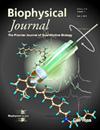Effect of RNA on the supramolecular architecture of α-synuclein fibrils.
IF 3.2
3区 生物学
Q2 BIOPHYSICS
引用次数: 0
Abstract
Structural changes associated with protein aggregation are challenging to study, requiring the combination of experimental techniques providing insights at the molecular level across diverse scales, ranging from nanometers to microns. Understanding these changes is even more complex when aggregation occurs in the presence of molecular co-factors like nucleic acids and when the resulting aggregates are highly polymorphic. Infrared (IR) spectroscopy is a powerful tool for studying protein aggregates since it combines the label-free sensitivity to the cross-β architecture, an inherent feature of protein supramolecular aggregates, with the possibility to reach nanoscale sensitivity by leveraging atomic force microscopy-assisted (AFM-assisted) detection. Here, we present a combined approach that detects IR spectral markers of aggregation using various IR spectroscopy techniques, covering micro- to nano-scale ranges, to study the effect of RNA on the supramolecular architecture of α-synuclein amyloid aggregates. We show a clear impact of RNA consistent with enhanced inter-molecular forces, likely via a stronger hydrogen-bonded network stabilizing the cross-β architecture. AFM-assisted IR spectroscopy was crucial to assess that the more ordered the aggregates are, the stronger the structural impact of RNA. In addition, an RNA-induced reduction of the degree of polymorphism within the aggregate population is obtained.RNA对α-突触核蛋白原纤维超分子结构的影响。
与蛋白质聚集相关的结构变化的研究具有挑战性,需要结合实验技术,提供从纳米到微米的不同尺度的分子水平的见解。当聚集发生在像核酸这样的分子辅助因子的存在下,并且当最终的聚集是高度多态的时候,理解这些变化就更加复杂了。红外(IR)光谱是研究蛋白质聚集体的强大工具,因为它结合了蛋白质超分子聚集体的固有特征-交叉β结构的无标记灵敏度,以及利用原子力显微镜辅助(afm辅助)检测达到纳米级灵敏度的可能性。在这里,我们提出了一种结合的方法,利用各种红外光谱技术检测聚集的红外光谱标记,覆盖微观到纳米尺度范围,研究RNA对α-突触核蛋白淀粉样蛋白聚集体的超分子结构的影响。我们发现RNA的明显影响与增强的分子间力一致,可能是通过更强的氢键网络稳定交叉β结构。原子力显微镜辅助的红外光谱对于评估聚集体越有序,RNA的结构影响越强至关重要。此外,在总群体中获得了rna诱导的多态性程度的降低。
本文章由计算机程序翻译,如有差异,请以英文原文为准。
求助全文
约1分钟内获得全文
求助全文
来源期刊

Biophysical journal
生物-生物物理
CiteScore
6.10
自引率
5.90%
发文量
3090
审稿时长
2 months
期刊介绍:
BJ publishes original articles, letters, and perspectives on important problems in modern biophysics. The papers should be written so as to be of interest to a broad community of biophysicists. BJ welcomes experimental studies that employ quantitative physical approaches for the study of biological systems, including or spanning scales from molecule to whole organism. Experimental studies of a purely descriptive or phenomenological nature, with no theoretical or mechanistic underpinning, are not appropriate for publication in BJ. Theoretical studies should offer new insights into the understanding ofexperimental results or suggest new experimentally testable hypotheses. Articles reporting significant methodological or technological advances, which have potential to open new areas of biophysical investigation, are also suitable for publication in BJ. Papers describing improvements in accuracy or speed of existing methods or extra detail within methods described previously are not suitable for BJ.
 求助内容:
求助内容: 应助结果提醒方式:
应助结果提醒方式:


